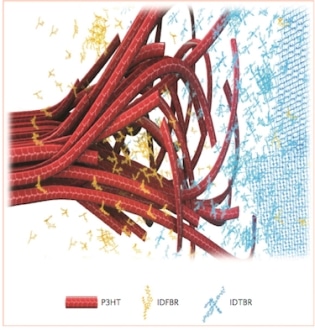Dec 5 2016
Researchers in the UK, Saudi Arabia, Germany and the US have succeeded in making highly efficient and stable ternary solar cells by combining two non-fullerene acceptors with a cheap and readily available donor semiconducting polymer called P3HT and a high-efficiency low-bandgap polymer called PCE10 in a single-layer bulk-heterojunction device. The devices have efficiencies of nearly 8% and more than 11%, respectively.
 A P3HT blend
A P3HT blend
“Our work shows that it is possible to significantly improve the performance of solar cell devices with what had previously been considered to be low-cost organic materials,” team leader Iain McCulloch of Imperial College London and KAUST in Saudi Arabia tells nanotechweb.org. “This completely changes the outlook for this materials class. Secondly, we have found that it is possible to make high performing, more stable devices without using expensive and poorly light-absorbing fullerenes.”
Organic photovoltaics today are mainly based on fullerene acceptor molecules combined with low-bandgap donor polymers that are difficult and costly to make. Researchers have been looking into alternatives to these materials and have recently found that inexpensive, non-fullerene semiconducting polymers that can easily be produced in flow or micro-reactors and even using “green” solvents could fit the bill here.
The photocurrent and voltage trade-off
McCulloch’s team discovered that solar cells containing a non-fullerene acceptor called IDTBR mixed with P3HT improves the power conversion efficiencies (PCEs) of solar cells to up to 6.4%. What is more, they say that multicomponent heterojunctions (ternary or higher) are also promising ways to overcome the PCE bottleneck associated with binary bulk-heterojunction solar cells. The problem here, however, is that it is difficult to simultaneously increase the open-circuit voltage and short-circuit current in such devices because of the trade-off between photocurrent and voltage – increasing one invariably decreases the other.
“We have now found that it is possible to circumvent this trade-off in organic solar cells,” explains team member and first author of this study Derya Baran, who is at Imperial, KAUST and IEK5-Photovoltaics in Jülich, Germany. “We can in fact add a third component to our high-performing devices to boost the voltage without compromising the current. This is a significant advance when it comes to creating active-layer material blends for solar cells.”
Better light harvesting
The researchers made highly efficient solar cells by combining P3HT with two non-fullerene acceptors in a ternary blend. They also extended this approach by using a high-efficiency, low-bandgap polymer PCE10 in place of P3HT. The P3HT-based cell has a PCE of around 7.7% and the PCE10-based one a PCE of around 11.0%.
These improvements come thanks to changes in the microstructure of the blends that reduce charge (electron and hole) recombination and increase the photovoltage, they say. This leads to better light harvesting by the materials across the visible region of the electromagnetic spectrum.
“Our low-cost semiconducting polymer-based devices exceed record performances and this will open up application areas where cost is the key driver,” says McCulloch.
The team, which includes researchers from Stanford University in the US, Friedrich-Alexander-University Erlangen-Nuremberg and the University of Duisberg-Essen, both in Germany, report on the ternary solar cells in Nature Materials doi:10.1038/nmat4797.